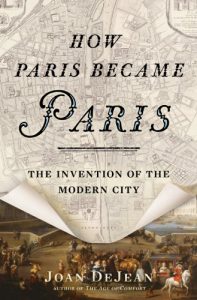How Paris Became Paris
Nineteenth century civic planner Baron Haussman is often given credit for transforming Paris into a modern city: a rebuilding massive project of bridges, wide boulevards and public spaces.
In How Paris Became Paris: The Invention of the Modern City, historian Joan DeJean (The Age of Comfort) argues that the real transformation occurred two centuries earlier, when Henri IV set out to rebuild a city that had been ravaged by Catholic and Protestant alike during the thirty-six years of the Wars of Religion. In 1597, wolves roamed freely in the French capital; by 1700, Paris was synonymous with culture, glamour and fashion.
Beginning with the building of the Pont Neuf (literally, the New Bridge), DeJean tells the story of a hundred years of royal vision, private funding, innovative real estate development and public planning. She also looks at how physical changes to the city created new behaviors, new institutions, and new problems. Many of the things that we think of as typically urban first appeared at this time: from public transportation and sidewalks to traffic jams and tourists. (Not the same thing as pilgrims.) Other changes are less familiar: new public spaces in which to promenade led to the new crime of cloak-snatching.
DeJean is also concerned with more than just seventeenth century urban renewal. Using a range of sources including contemporary guidebooks, plays and travel accounts, she explores how the city’s image was reinvented –creating a fantasy of Paris as what Claude Monet would later describe as “that dizzying place.”





